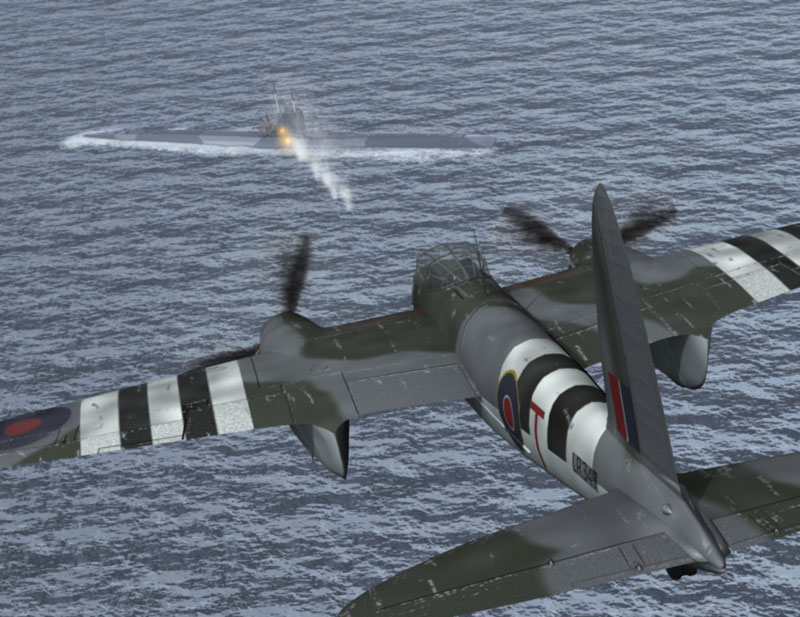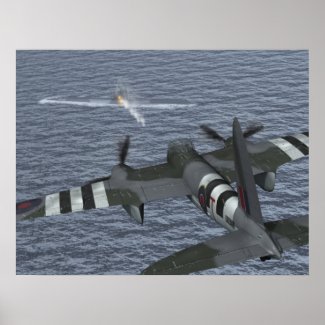De Havilland Mosquito

De Havilland Mosquito; digital Illustration by Les Still
On 10th June 1944 four de Havilland Mosquitoes from 248 Squadron, flying from RAF Portreath, Cornwall, led by de Havilland Mosquito LR347, T - Tommy, crewed by Flt. Lt. Stanley G Nunn and Flying Officer J. M. Carlin, took part in an attack on U-821 off Ushant by
The crew of the U-boat subsequently abandoned ship and the craft was later sunk by a 206 Sqn Liberator. On 16th July 1944 this aircraft was badly damaged by German anti aircraft fire and a subsequent belly landing at Portreath.
248 Squadron RAF
In August 1918 No.248 Squadron RAF was formed at Hornsea Mere from the RNAS Flight already there. They were equipped with Short 184 and Sopwith Baby floatplanes and flew coastal patrols off the Yorkshire coastline until the Armistice. The squadron was disbanded at Hornsea on 6 March 1919. No. 248 Squadron reformed at Hendon as a fighter squadron on 30 October 1939 and received Bristol Blenheim Mk IFs in December. Two months later it was transferred to Coastal Command, moving to North Coates, and slowly built up with Blenheim Mk IVFs, which it used on reconnaissance and attack patrols from it's Sumburgh base. These continued for a year, the squadron moving south to Bircham Newton in June 1941 to re-equip with Bristol Beaufighter MK ICs. These were brought into operations two months later, and No. 248 was mainly occupied with attacks on enemy shipping along the Dutch coast. In 1942 it returned to Scotland and the Northern North sea until August, when the squadron flew out to support a relief convoy to Malta. Once there, it left it's aircraft behind for other squadrons and rebuilt itself at Talbenny, moving to Cornwall in September 1942. It's operational area was now the Bay of Biscay and the Western Approaches, using Beaufighter Mk VICs and TF.MKXs. It also indulged in attacks across the Channel, escorting aircraft attacking shipping off the Normandy and Brittany coasts.
In December 1943 / January 1944 de Havilland Mosquito FB.Mk VIs replaced the Beaufighters, and in early June 1944, with 235 Squadron, formed part of the first Mosquito Strike Wing of Coastal Command. There was a special detachment in 248 Squadron which flew a modified form of Mosquito VI, the Mosquito Mark XVIII, with the four cannon being removed and replaced with a 57mm anti tank gun firing six pound shells. The MKXVIII, called the Tsetse, retained it's machine guns and could carry underwing drop tanks or two 500lb bombs. The conversion proved successful. On 23 March 1955, U-976 was sunk in the Bay of Biscay by two Tsetses.
By September 1944, the Allies had advanced into Belgium and parts of Holland and the two Mosquitoes squadrons of the Portreath Wing, 235 and 248, moved to Banff in North East Scotland to join the Banff Strike Wing, serving there until World war II was over and flying against shipping along the Norwegian coast. With the war over it moved south to it's peacetime bases at Chivenor and then Thorney Island, where it disbanded on 30 September 1946.
De Havilland Mosquito
Origin;- The de Havilland Aircraft Company, Hatfield and Leavesden, also built by Airspeed, Percival Aircraft and Standard Motors (Canley), de Havilland Aircraft Pty, Australia, de Havilland Aircraft of Canada.
Type;- Designed as high speed day bomber, see below for subsequent variants.
Engines;- (Mks II, III, IV and early VI) two 1,230hp Rolls-Royce Merlin 21 or (late FB VI) 1,635hp Merlin 25, (Mk IX) 1,680np Merlin 72, (Mk XVI) Merlin 72 or 1,710hp Merlin 73 or 77, (Mk30) 1,710hp Merlin 76, (Mk33) 1,640hp Merlin 25, (Mks 34, 35 and 36) 1,690hp Merlin 113/114. Many other variants had corresponding Merlins made by Packard.
Dimensions;- Span (except for MK.VX) 54'2" (16.5m), length (most common) 40'6" (12.34m), (bombers) 40'10" (radar equipped fighters and Mk 34-38) typically 41'9" (Mk 39) 43'4", height (most common) 15'4" (4.66m).
Weights;- Empty (Mk2 II-IV) about 14,100lb, (Mks VII-30) about 15,200lb, beyond MK 30) about 15,800-16,800lb, maximum gross (Mks II and III) around 17,500lb, Mks IV and VI) about 22,500lb, (later night fighters) about 20,500lb (but HF XV only 17,395lb), (Mks IX, XVI and Marks beyond 30) typically 25,000lb (11.340kg).
Performance;- Maximum speed from 300mph (TT39 with M4 sleeve) to 370mph (595km/h) for early night fighters, 380 mph (612km/h) for III, IV and VI, 410mph (660km/h) for IX, XVI and 30, and 425mph for 34 and 35. Service ceiling from 30,000ft (9144m) for low rated naval versions to 34,500ft (10,520m) for most marks to around 40,000ft (12190m) for high blown versions with Mk XV reaching 44,000ft (13410m); combat range typically 1,880 miles (2990km), with naval TFs down at 1,260 miles and PR 34 up to 3,500 miles.
Performance;- Maximum speed from 300mph (TT39 with M4 sleeve) to 370mph (595km/h) for early night fighters, 380 mph (612km/h) for III, IV and VI, 410mph (660km/h) for IX, XVI and 30, and 425mph for 34 and 35. Service ceiling from 30,000ft (9144m) for low rated naval versions to 34,500ft (10,520m) for most marks to around 40,000ft (12190m) for high blown versions with Mk XV reaching 44,000ft (13410m); combat range typically 1,880 miles (2990km), with naval TFs down at 1,260 miles and PR 34 up to 3,500 miles.
Armament;- see below.
History;- see below.
History;- see below.
Users;- Australia, Belgium, Canada, China, Czechoslavakia, France, Yugoslavia, New Zealand, Norway, Soviet Union, Turkey, UK (RAF, RN, BOAC) US (AAF).
Development;- The de Havilland Aircraft Co planned the Mosquito in October 1938 as a high speed unarmed day bomber with the added attraction of wooden construction to ease the strain on Britain's pressed material suppliers. The Air Ministry showed no interest, suggesting instead the Hatfield plant should make wings for existing heavy bombers. In 1940, with extreme reluctance, it was agreed to allow the firm to proceed, the only role thought possible for an unarmed aircraft being reconnaissance. The first prototype, built secretly at Salisbury Hall by a team which grew from 12 in January 1940 to 30 in the summer, was painted yellow on 26 November 1940. From it stemmed 7,781 aircraft built in Britain, Canada and Australia of the following types.
PR.I Unarmed photo-reconnaissance, with span lengthened from 57'6" of prototype to 54'2" but still with short engine nacelles.
F II Night fighter with pilot and observer side by side, flat bullet proof windscreen, extended nacelles ( as in all subsequent aircraft, with flaps divided into inner and outer segments) and armament of four 20mm Hispano cannon with 300 rounds each under the floor and four 0.303in Brownings with 2,000 rounds each in the nose. First flew 15 May 1941, subsequently fitted with AI Mk IV or V radar or Turbolight searchlight.
T.III Dual control trainer' first flown January 1942 but produced mainly after the war (last delivery 1949)
B.IV Unarmed bomber, carrying four 500lb (227kg) bombs internally, first delivery to 105 Sqn at Swanton Morley November 1941, making first operational sortie ( Cologne, the morning after the first 1,000 bomber night attack) on 31 May 1942. Some later fitted with bulged bomb bays for 4,000lb (1814kg) bomb.
FB.VI Fighter bomber and intruder, by day or night, same guns as F.II, but two 250lb (113kg) bombs in rear bay and two more (later two 500lb) on wing racks on wing racks, alternatively 50 or 100 gal drop tanks, mines, depth charges or eight 60lb rockets. Some fitted with AI radar. Total production 2,584, more than any other mark.
B.VII Canadian built Mk IV used in North America only.
PR.VIII Reconnaissance conversion of B.IV with high blown Merlin 61.
Mk IX Important advance in bomber (B.IX) and reconnaissance (PR.IX) versions, high blown two stage engines, bulged bomb bay for 4,000lb bomb or extra fuel, much increased weight, paddle blade propellers and new avionics (Rebecca Boozert, Oboe or H2S Mk.VI).
NF.XII Conversion of F.II fitted with new thimble nose containing AI Mk VIII centimetric radar in place of Brownings.
NF.XIII Similar to MK XII but built as new with thimble or bull nose and same wing as MK VI for drop tanks or other stores, flew August 1943.
NF.XV High altitude fighter with wings extended to 59ft., pressurised cockpit, lightened structure, AI Mk VIII in nose and belly pack of four 0.303in Brownings to combat Ju86P raiders.
Mk.XVI Further major advance with two stage Merlins, bulged bomb bay and pressurised cockpit. PR XVI flew July 1943. B.XVI in January 1944, over 1,200 of latter being used for high level nuisance raids with 4,000lb bombs.
NV.MkXVII Night fighter with new AI Mk X or SCR 720 (some with tail looking scanner also) four 20mm cannon each with 500 rounds.
FB.XVIII Dubbed the Tsetse Fly, this multi role Coastal Command fighter had low blown engines and carried a 57mm six pounder Mollins gun with 25 rounds plus four Brownings, as well as eight 60lb rockets or bombs.
NF.XIX MkXIII developed with AI VIII or X or SCR 720 in bulged Universal Nose and low blown Merlin 25s.
B.XX Canadian built B.IV (USAAF designation F-8).
FB.21 to T.29 Canadian marks with Packard V-1650 (Merlin) engines, not all built.
NF.30 Night fighter with two stage engine, paddle blades, AI Mk X and various sensing, spoofing or jamming avionics, based on MkXIX.
PR.32 Extended span reconnaissance version with Merlin 113/114.
Mk.33 First Royal Navy sea Mosquito version, with power folding wings, oleo main legs (in place of rubber in compression), low blown engines driving four blade propellers, arrester hook, four 20mm cannons, torpedo (or various bomb / rocket loads), American ASH radar and rocket JATO boost.
PR.34 Strategic reconnaissance version, with 113/114 engines, extra bulged belly for 1,269 gal of fuel (200gal drop tanks) and pressure cabin.
B.35 Equivalent bomber version with PR and target tug offshoots.
NF.36 Post-war fighter with 113/114 engines and AI Mk X.
TF.37 Naval torpedo fighter, basically Mk 33 with AI/ASV Mk XIII.
NF.38 Final fighter, mainly exported. AI MK IX, forward cockpit.
TT.39 Complete rebuild by General Aircraft as specialised target tug.
FB.40 Australian built MK VI with PR.40 as conversions.
PR.41 Australian built derivative of PR.IX and MK 40
T.43 Australian trainer all Australian production had Packard engines.
PR.I Unarmed photo-reconnaissance, with span lengthened from 57'6" of prototype to 54'2" but still with short engine nacelles.
F II Night fighter with pilot and observer side by side, flat bullet proof windscreen, extended nacelles ( as in all subsequent aircraft, with flaps divided into inner and outer segments) and armament of four 20mm Hispano cannon with 300 rounds each under the floor and four 0.303in Brownings with 2,000 rounds each in the nose. First flew 15 May 1941, subsequently fitted with AI Mk IV or V radar or Turbolight searchlight.
T.III Dual control trainer' first flown January 1942 but produced mainly after the war (last delivery 1949)
B.IV Unarmed bomber, carrying four 500lb (227kg) bombs internally, first delivery to 105 Sqn at Swanton Morley November 1941, making first operational sortie ( Cologne, the morning after the first 1,000 bomber night attack) on 31 May 1942. Some later fitted with bulged bomb bays for 4,000lb (1814kg) bomb.
FB.VI Fighter bomber and intruder, by day or night, same guns as F.II, but two 250lb (113kg) bombs in rear bay and two more (later two 500lb) on wing racks on wing racks, alternatively 50 or 100 gal drop tanks, mines, depth charges or eight 60lb rockets. Some fitted with AI radar. Total production 2,584, more than any other mark.
B.VII Canadian built Mk IV used in North America only.
PR.VIII Reconnaissance conversion of B.IV with high blown Merlin 61.
Mk IX Important advance in bomber (B.IX) and reconnaissance (PR.IX) versions, high blown two stage engines, bulged bomb bay for 4,000lb bomb or extra fuel, much increased weight, paddle blade propellers and new avionics (Rebecca Boozert, Oboe or H2S Mk.VI).
NF.XII Conversion of F.II fitted with new thimble nose containing AI Mk VIII centimetric radar in place of Brownings.
NF.XIII Similar to MK XII but built as new with thimble or bull nose and same wing as MK VI for drop tanks or other stores, flew August 1943.
NF.XV High altitude fighter with wings extended to 59ft., pressurised cockpit, lightened structure, AI Mk VIII in nose and belly pack of four 0.303in Brownings to combat Ju86P raiders.
Mk.XVI Further major advance with two stage Merlins, bulged bomb bay and pressurised cockpit. PR XVI flew July 1943. B.XVI in January 1944, over 1,200 of latter being used for high level nuisance raids with 4,000lb bombs.
NV.MkXVII Night fighter with new AI Mk X or SCR 720 (some with tail looking scanner also) four 20mm cannon each with 500 rounds.
FB.XVIII Dubbed the Tsetse Fly, this multi role Coastal Command fighter had low blown engines and carried a 57mm six pounder Mollins gun with 25 rounds plus four Brownings, as well as eight 60lb rockets or bombs.
NF.XIX MkXIII developed with AI VIII or X or SCR 720 in bulged Universal Nose and low blown Merlin 25s.
B.XX Canadian built B.IV (USAAF designation F-8).
FB.21 to T.29 Canadian marks with Packard V-1650 (Merlin) engines, not all built.
NF.30 Night fighter with two stage engine, paddle blades, AI Mk X and various sensing, spoofing or jamming avionics, based on MkXIX.
PR.32 Extended span reconnaissance version with Merlin 113/114.
Mk.33 First Royal Navy sea Mosquito version, with power folding wings, oleo main legs (in place of rubber in compression), low blown engines driving four blade propellers, arrester hook, four 20mm cannons, torpedo (or various bomb / rocket loads), American ASH radar and rocket JATO boost.
PR.34 Strategic reconnaissance version, with 113/114 engines, extra bulged belly for 1,269 gal of fuel (200gal drop tanks) and pressure cabin.
B.35 Equivalent bomber version with PR and target tug offshoots.
NF.36 Post-war fighter with 113/114 engines and AI Mk X.
TF.37 Naval torpedo fighter, basically Mk 33 with AI/ASV Mk XIII.
NF.38 Final fighter, mainly exported. AI MK IX, forward cockpit.
TT.39 Complete rebuild by General Aircraft as specialised target tug.
FB.40 Australian built MK VI with PR.40 as conversions.
PR.41 Australian built derivative of PR.IX and MK 40
T.43 Australian trainer all Australian production had Packard engines.
from Military Aviation Library - World War 2 British Aircraft.
Free Tarot Readings by Alison Day
Mystic Realms has linked up with Lotus Tarot, probably the best Tarot Reading site on the internet today.


